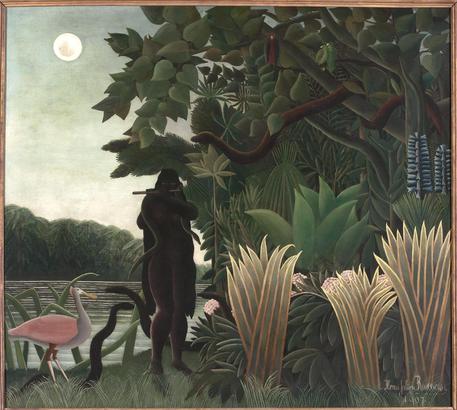

 |
Venice, March 6 - In a post-Impressionist Paris brushed by the winds of the avant-garde, Henri Rousseau created a form of painting reminiscent of votive offerings while paving the way for a certain type of magic realism. "I have already been told I do not belong to my century," Rousseau, also known as 'Le Douanier', wrote. Venice's Fondazione Musei Civici is holding an exhibition on the artist - the first in Italy, with the exception of a hall at the 1950 Biennale - in the Doge's quarters of Palazzo Ducale from March 6 to July 5.
The French artist (1844-1910), born in Laval, restored drawing as foundational to art and only in the last 20 years of life did he focus entirely on painting. Rousseau made paintings filled with the charm of forests populated by tigers, monkeys, jaguars and a snake enchantress and gave life to portraits and landscapes that seem dimension-less. "He wasn't interested in light," said Gabriella Belli - who alongside Guy Cogeval is behind the exhibition - "there are no shadows. It is a picture of extreme synthesis, made of absolute compositional essentiality." The 'self-taught' painter who avoided all attempts to categorize him achieved success and saw his works collected by the such 'stars' of the art world as Pablo Picasso and Wassily Kandisky.
In a 1965 photo, the Spanish artist was caught in his atelier with two small Rousseau paintings in hand.At a certain point, Le Douanier came to represent an alternative direction to those of Gauguin and Picasso: that of 'virginal realism, archaic candor', which would enable German and Italian painters a decade later "to begin again to build a new European style of painting", that of the Post-Avantgarde. "A boring man who lived humbly, but was querulous in his demands to promote his works," the artist was described by Belli, who noted that "his paintings gained a place among avant-garde painters in Paris. The artists saw Rousseau's originality, his being far from all other ways of painting." The exhibition has been designed as a sort of journey on two levels for the discovery of 'Planet Rousseau', with about 40 of his works including 'Myself: Landscape Portrait', from 1889-1890; 'The War or the Ride of Discord', from 1894; 'The Snake Enchantress', from 1907; and 'Oval Ball Players', from 1908. The works are placed alongside about 60 others, ranging from the primitives to Giorgio Morandi and Carlo Carrà, Gauguin, Seurat, Ernst, Klee, nineteenth-century US art and Frida Kahlo, in an attempt to show the artist next to his 'contemporaries' and those that influenced him or were influenced by him. "Rousseau is the only figure that I often get obsessed with", wrote Franz Marc, leading member of the 'Blaue Reiter', which saw the artist as its precursor. The exhibition, in its presentation of works from previous centuries, offers a new look at the possible roots of an artist often seen as having no peer.
 Attendants-to-be join Mr. & Miss Campus Contest
Attendants-to-be join Mr. & Miss Campus Contest China hosts overseas disaster relief exercise for the first time
China hosts overseas disaster relief exercise for the first time 20 pairs of twins who will become flight attendants in Sichuan
20 pairs of twins who will become flight attendants in Sichuan J-11 fighters in air exercise
J-11 fighters in air exercise PLA soldiers operating vehicle-mounted guns in drill
PLA soldiers operating vehicle-mounted guns in drill Beauties dancing on the rings
Beauties dancing on the rings Blind carpenter in E China's Jiangxi
Blind carpenter in E China's Jiangxi Top 10 highest-paid sports teams in the world
Top 10 highest-paid sports teams in the world In photos: China's WZ-10 armed helicopters
In photos: China's WZ-10 armed helicopters Obama is sowing discontent in S.China Sea
Obama is sowing discontent in S.China Sea Rescuers work through night to reach cruise ship survivors
Rescuers work through night to reach cruise ship survivors Driving through limbo
Driving through limbo Facing down MERS
Facing down MERSDay|Week